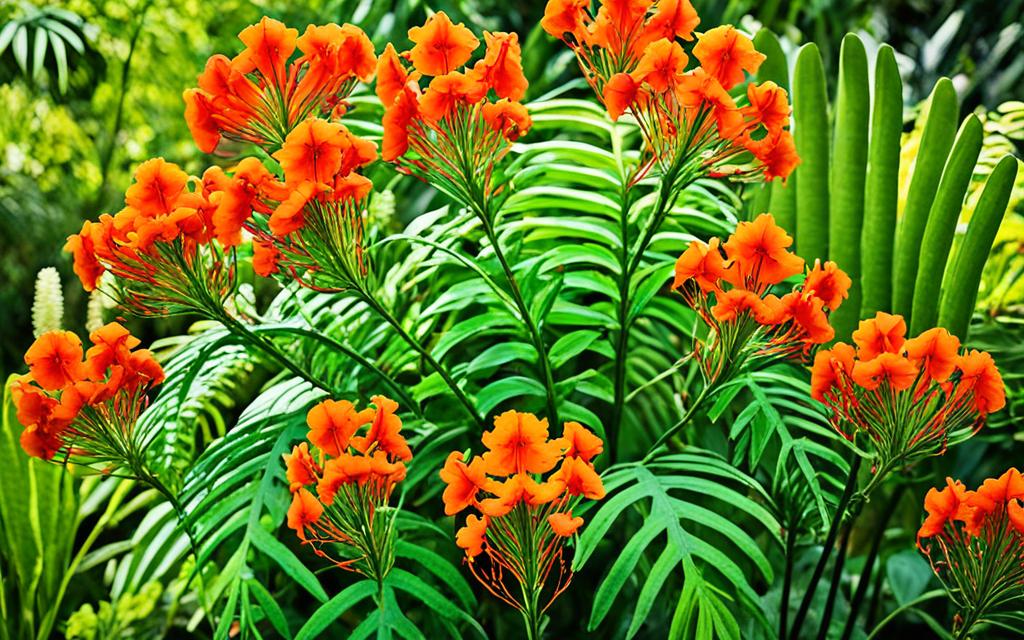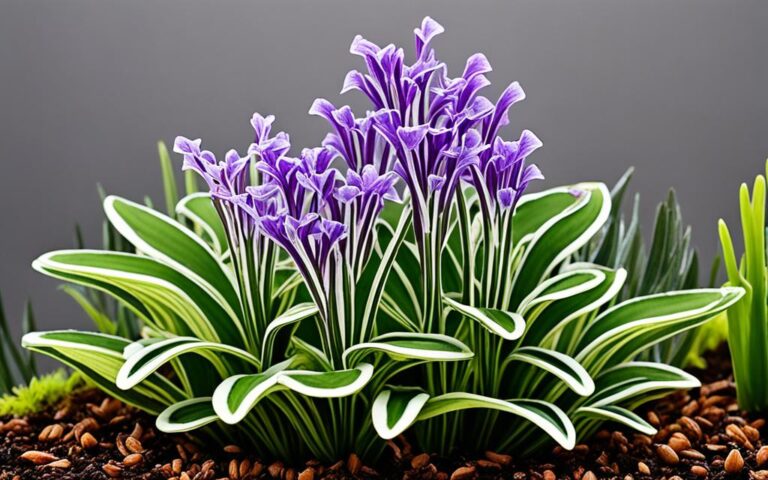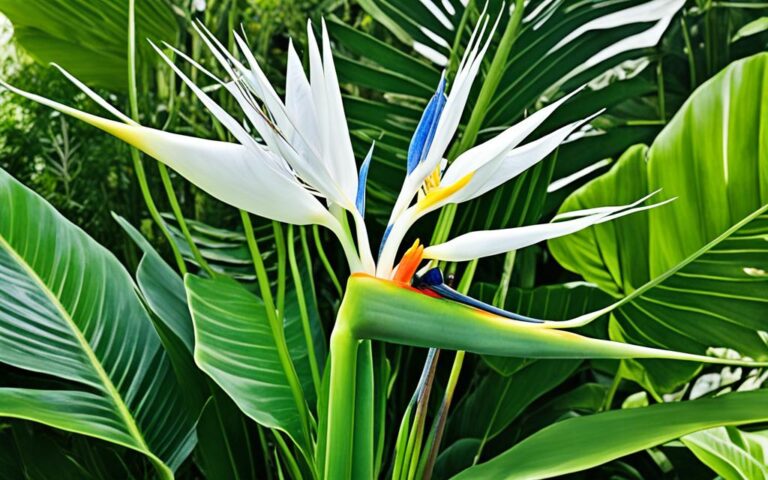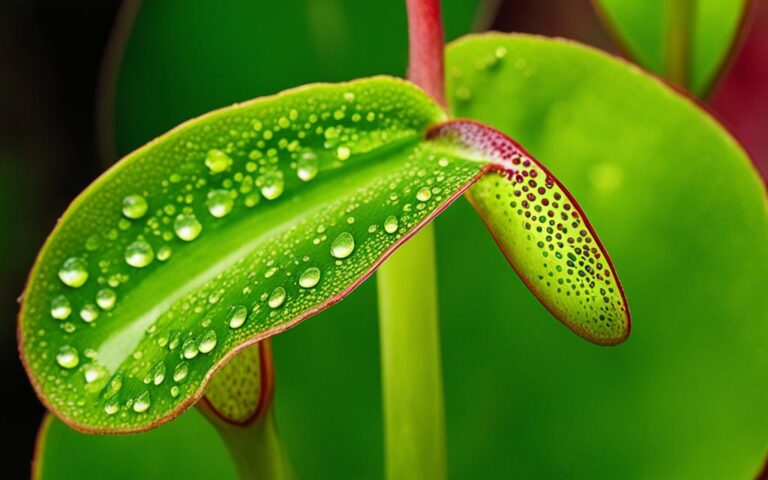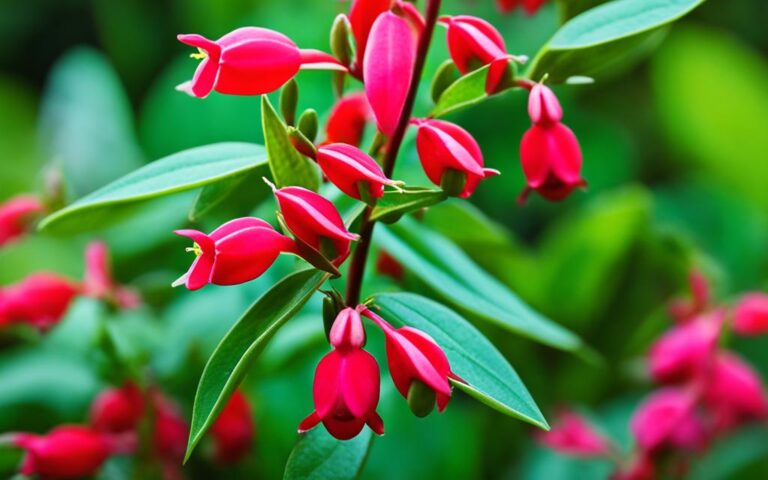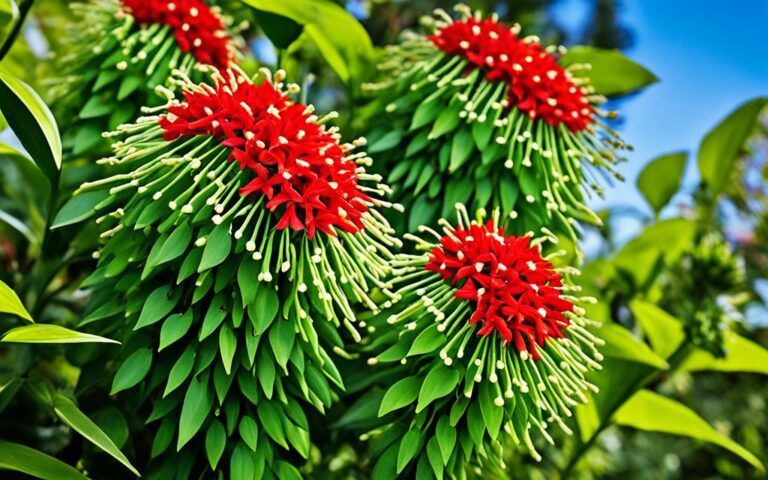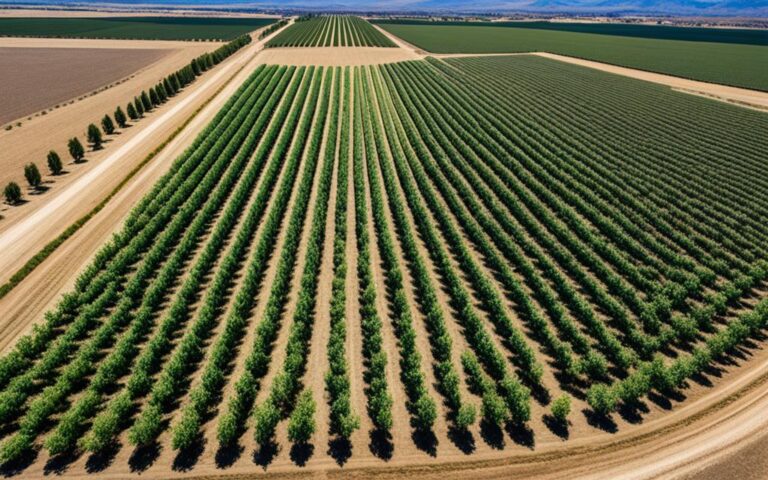Pride of Barbados Plant: Stunning Tropical Shrub
Picture a vibrant tropical shrub that turns your garden into an exotic oasis. The Pride of Barbados, known as Caesalpinia pulcherrima, is this plant. It’s found along the Gulf Coast and even in Central Texas, wowing people with its delicate yet strong flowers.
Key Takeaways
- The Pride of Barbados is a fast-growing shrub or small tree that can reach heights of up to 10 feet.
- The plant’s vibrant orange and red flowers, with yellow also available, bloom within 60 days of emerging from dormancy.
- Pride of Barbados thrives in full sun but can also grow in light shade, making it versatile for various garden settings.
- This drought-tolerant plant is well-suited for Austin’s climate, thanks to its ability to thrive in alkaline soils.
- The Texas Superstar® program has designated the Pride of Barbados as a reliable and high-quality plant for the state.
Introduction to Pride of Barbados Plant
The Pride of Barbados, known as Caesalpinia pulcherrima, is a beautiful tropical shrub. It’s part of the pea family (Fabaceae). This plant is famous for its bright, eye-catching flowers. It goes by many names like Barbados Flowerfence, Peacock Flower, and Dwarf Poinciana.
Botanical Name and Common Names
The name Caesalpinia pulcherrima means “very pretty Caesalpinia.” It suits this lovely flowering shrub perfectly. The many names for the Pride of Barbados show how it’s loved worldwide.
Native Origin and Global Cultivation
This plant likely started in the West Indies and tropical Americas. Its beauty and ability to adapt made it popular worldwide. Now, it’s a favorite in gardens and landscapes in warm places.
Striking Floral Display
The Pride of Barbados plant is known for its amazing flowers. These blooms come in clusters and shine with a bright orange-red color. They also have a hint of gold on the edges.
Each flower has five petals and very long, red stamens. This makes the Pride of Barbados a standout among plants that love the heat.
Vibrant Orange-Red Flowers with Prominent Stamens
The Pride of Barbados has beautiful red and orange flowers with gold highlights. Each flower has five petals and ten bright red stamens that really stand out. The leaves can grow up to 15 inches long, adding to the plant’s beauty.
Bloom Time and Duration
In warm places, the Pride of Barbados flowers all year. But in areas with some frost, they bloom in late summer and fall. This adds a splash of color during the changing seasons.
| Flower Color | Flower Size | Bloom Time | Bloom Duration |
|---|---|---|---|
| Orange-Red with Gold Accents | Flowers up to 15 inches in length | Year-round in tropics, late summer to fall in temperate climates | Blooms persist for several months |
“The Pride of Barbados is one of the most captivating heat-loving plants, with its vibrant orange-red flowers and prominent red stamens.”
Plant Characteristics
Growth Habit and Size
The Pride of Barbados is an evergreen in warm places, but turns deciduous in cold areas. In the tropics, it can grow 15-20 feet tall, spreading wide with branches. But in cooler places, it grows 5-8 feet tall and is more compact.
Foliage Description
The leaves of the Pride of Barbados look like ferns and are twice-compound. Each leaf has many small, oval leaflets. The stems and branches have sharp spines, making the plant stand out.
| Characteristic | Tropical Climates | Cooler Climates |
|---|---|---|
| Height | 15-20 feet | 5-8 feet |
| Spread | 15-20 feet | 10-12 feet |
| Leaf Type | Fernlike, twice-compound | Fernlike, twice-compound |
| Leaflet Shape | Oval | Oval |
| Stem and Branch Spines | Present | Present |
The fernlike leaves and oval leaflets of the Pride of Barbados make it stand out. This plant has a unique look that’s different from other shrubs and small trees.
Hardiness and Cold Tolerance
The Pride of Barbados (Caesalpinia pulcherrima) is a tough tropical shrub. It grows well in USDA Hardiness Zones 8 through 11. This plant is known for its beautiful flowers and can handle cold weather well.
In places with mild winters, the Pride of Barbados comes back in the middle of spring. It can survive temperatures as low as 18°F. But in areas with very cold winters, it might die back to the ground. In these places, gardeners can grow it as an annual, planting it every spring.
Even without frost, the Pride of Barbados may lose its leaves when it gets into the 40s Fahrenheit. This makes it a great choice for gardens in different climates. It’s perfect for gardeners and designers looking for variety.
| USDA Zone | Cold Tolerance | Plant Behavior |
|---|---|---|
| 8B and Warmer | 18°F | Reliably returns in spring |
| Colder Zones | Freezing Temperatures | May die to the ground, grown as annual |
The Pride of Barbados is very hardy and can handle cold well. This makes it a great choice for gardens and landscapes in areas with changing winter weather.
Growing Requirements
The Pride of Barbados plant needs certain conditions to grow well. It’s important to know about its pride of barbados light requirements, pride of barbados soil preferences, and pride of barbados water needs.
Ideal Light Conditions
This plant loves full sun and blooms best in direct sunlight. It can handle some shade, but it won’t be as bright. Southern exposure helps it grow faster and stronger than northern exposure.
Soil Preferences
The Pride of Barbados can grow on many soil types, from alkaline to acidic. But, it does best in well-drained soil. Avoid planting it in areas with poor drainage to keep it healthy.
Water Needs
Once it’s established, this plant can handle drought. But, it grows and flowers better with regular moisture and nitrogen. Make sure to water it often, especially when it’s dry or very hot.
“The Pride of Barbados is a versatile plant that can thrive in a variety of growing conditions, but understanding its specific light, soil, and water requirements is key to ensuring a vibrant and healthy plant.”
pride of barbados plant
The Pride of Barbados, also known as the Dwarf Poinciana (Caesalpinia pulcherrima), is a fast-growing plant. It thrives in tropical and subtropical climates. This plant is famous for its beautiful orange-red and gold-edged flowers. These flowers attract many butterflies and hummingbirds.
The plant’s flowers are bowl-shaped, about 2-3 inches wide. They have five red and orange petals and ten bright red stamens. There are around 70 species of these plants worldwide. The Pride of Barbados is native to the West Indies and tropical America.
In frost-free areas, the Caesalpinia pulcherrima can grow 15-20 feet tall. In colder zones, it acts as a returning perennial. It dies to the ground after frost but comes back reliably in USDA Zone 8B and above.
This plant is easy to grow and thrives in many soils. It prefers full sun to partial shade and is drought-tolerant once established. This makes it a great choice for any garden or landscape.
| Characteristic | Description |
|---|---|
| Bloom Time | Blooms continuously through October |
| Mature Size | 5-8 feet tall and 4-5 feet wide |
| Light Needs | Full sun to partial shade |
| Water Needs | Drought-tolerant once established |
The Pride of Barbados plant can spread on its own and might become weedy. But its beautiful flowers and easy care make it popular. It’s great as a specimen plant, in a mixed border, or as a colorful screen or hedge. The Caesalpinia pulcherrima truly stands out, adding vibrant color and life to any space.
Propagation Methods
The Pride of Barbados plant is easy to spread through different methods. You can use seed or vegetative propagation to grow more of this beautiful tropical shrub.
Seed Propagation
Seed propagation is the top way to grow the Pride of Barbados. You can collect and plant the shiny brown seed pods. To help them grow faster, nick the seeds with a file before planting.
This plant can grow on its own in good conditions. It can become a bit too common in some places.
The best temperature for germinating Caesalpinia pulcherrima seeds is 25-30°C (77-86°F). They start to sprout in 10-14 days. Move seedlings to a new spot when they are 15 cm tall and feed them once a month until they are fully grown.
Vegetative Propagation
You can also grow the Pride of Barbados by using cuttings or division. Cuttings should be at least 10 cm long and taken early in the morning. Using rooting hormone helps roots grow faster.
Other ways to propagate include layering and air-layering. But, there’s not much info on these methods.
Be careful not to overwater during propagation to avoid root rot. Keep the soil just right and clean your tools before use to prevent diseases.
Care and Maintenance
The Pride of Barbados is a beautiful tropical shrub that needs the right care to thrive. It’s important to prune and train this plant to keep it looking great and growing well.
Pruning and Training
Pruning the Pride of Barbados helps it grow bushy and compact. Cut it back to the ground in late winter or early spring for a fuller look. After it blooms, pruning again helps it focus on new growth for the next season.
Pruning above leaf nodes helps control where the plant grows. Removing dead flowers makes it focus on blooming again. This keeps your plant looking lively and full of flowers.
To keep your Pride of Barbados looking its best, cut it back by about one-third in early spring. Regular trimming keeps it in shape and encourages healthy growth. This care routine keeps your plant looking great all season.
By pruning and training your Pride of Barbados, you can keep it healthy and beautiful. These steps make sure your plant looks stunning all season long.
| Pruning Tip | Benefit |
|---|---|
| Cut back to the ground in late winter/early spring | Encourages dense, bushy growth |
| Prune above leaf nodes | Directs new growth for shaping |
| Remove spent flowers | Redirects energy to new blooms |
| Rejuvenation pruning (1/3 cut back) | Stimulates fresh growth |
| Trim every few months | Maintains shape and redirects energy |
By following these pride of barbados care and pride of barbados maintenance tips, you can keep your plant looking stunning and vibrant. Proper pruning and training make it a beautiful part of your garden.
Pests and Diseases
The Pride of Barbados is usually tough and healthy. But, it can face pests and diseases. Keeping an eye on it and acting fast is key to keeping it looking great.
One big worry is over-watering, which can cause root rot and a soft base. On the other hand, dehydration makes leaves look limp. It’s important to keep the moisture right for the plant.
Leaf scorch can happen if the plant gets too much direct sunlight. It’s best to keep the Pride of Barbados in a spot that’s between 18-24°C (64-75°F) for its health.
- Common pests include aphids, spider mites, and mealybugs. These pests can be fought off with insecticidal soaps and neem oil.
- Fungal and mold problems, like powdery mildew, can make leaves look bad or have powdery spots. Checking the plant often helps spot these issues early.
- Not getting enough nutrients can cause problems too. Yellow leaves mean it needs more nitrogen, and black or brown spots mean it needs more nutrients overall. Too much food can burn the plant, while too little can cause deficiency.
- Root problems, such as root rot, make leaves curl. To fix this, repot the plant in soil that drains well and make sure the drainage is good.
By watching closely and fixing any problems fast, gardeners can keep the Pride of Barbados looking great in their gardens.
| Pest or Disease | Symptoms | Treatment |
|---|---|---|
| Aphids | Sap-sucking insects that can cause leaf curling and stunted growth | Insecticidal soap, neem oil |
| Spider Mites | Tiny spider-like pests that feed on leaves, causing discoloration and webbing | Insecticidal soap, neem oil |
| Mealybugs | Cottony-looking insects that feed on sap, leading to leaf yellowing and stunting | Insecticidal soap, neem oil |
| Powdery Mildew | White, powdery fungal growth on leaves and stems | Fungicide, improving air circulation |
| Root Rot | Mushy, discolored roots, often caused by overwatering | Repotting with well-draining soil, improving drainage |
Benefits and Landscape Uses
The Pride of Barbados is a stunning tropical shrub that brings many benefits to gardens and landscapes. It’s not just for its beautiful flowers. This plant has many features that make it great for any outdoor area.
Attracts Pollinators
This plant is a big help to pollinators, like butterflies, especially the Tiger Swallowtail. Its bright flowers are a great source of nectar. This makes it perfect for gardens that want to help local pollinators.
Drought Tolerance
The Pride of Barbados is also great for dry areas because it can handle drought well. Once it’s grown, it needs little water. This makes it perfect for gardens with little water or those who want to save water.
This plant is great for gardens because it looks beautiful, helps pollinators, and can survive with little water. It’s a top pick for anyone wanting a garden that looks good, is good for the environment, and is easy to take care of.
Varieties and Cultivars
The standard Caesalpinia pulcherrima, known as the Pride of Barbados, is well-known. But, there are other species and cultivars to explore. The Caesalpinia gillesii, or Yellow Bird of Paradise, has a different look with its yellow blooms.
The Pride of Barbados plant (Caesalpinia pulcherrima) is widely grown. It’s famous for its bright orange-yellow flowers with dark red stamens. This shrub can grow up to 3 meters tall, sometimes reaching 5 meters in Hawaii.
There are other cultivars and varieties to consider, like the Caesalpinia gillesii, or Yellow Bird of Paradise. It has yellow flowers, adding variety to the usual orange-red colors. These plants have the same lush foliage and grow well in USDA Hardiness Zones 9-11.
| Cultivar/Variety | Flower Color | Hardiness Zone | Mature Height |
|---|---|---|---|
| Pride of Barbados (Caesalpinia pulcherrima) | Orange-Red | 9-11 | 10-20 feet |
| Yellow Bird of Paradise (Caesalpinia gillesii) | Yellow | 9-11 | 10-20 feet |
Choosing the classic Pride of Barbados or its vibrant cousins brings a touch of the exotic to gardens. Their beautiful flowers and easy care make them great for warm climates.
Interesting Facts
The Pride of Barbados, also known as the Caesalpinia pulcherrima, is a stunning tropical shrub. It is the national flower of Barbados. This plant can grow on its own, making it tough and easy to care for in gardens.
This shrub grows fast, reaching up to 10 feet tall quickly. It becomes a beautiful centerpiece in any garden. Its quick growth shows how strong and hardy it is.
The Pride of Barbados can survive with little water once it’s grown. It’s perfect for gardens in dry areas. It also grows well in many types of soil, from acidic to alkaline.
Butterflies, hummingbirds, and bees love this plant. Its bright orange-red flowers are full of nectar. This draws many pollinators to the garden.
If you like gardening, you should try the Pride of Barbados. It looks beautiful, spreads on its own, and helps the environment. This plant is a must for any garden in Barbados.
In conclusion, the Pride of Barbados is a plant that deserves its national flower status. Its fast growth and ability to attract pollinators make it a great choice for gardens or landscaping projects.
Conclusion
The Pride of Barbados, or Caesalpinia pulcherrima, is a vibrant tropical shrub. It adds exotic beauty to gardens and landscapes. Its orange-red flowers and fernlike foliage make it stand out.
This shrub is adaptable to many growing conditions. It’s perfect as a specimen, in a mixed border, or as a screen. Gardeners and nature lovers will find it impressive and delightful.
The Pride of Barbados grows fast and shows off vibrant flowers. It’s also resistant to pests and diseases. It thrives in dry soils and full sun, ideal for hot climates.
It’s also known as a traditional medicine plant. As research continues, we may learn more about its health benefits.
In conclusion, the Pride of Barbados is a gem of the tropical landscape. It offers beauty, drought tolerance, and potential health benefits. This shrub makes a lasting impression, whether for its looks or its health uses.
